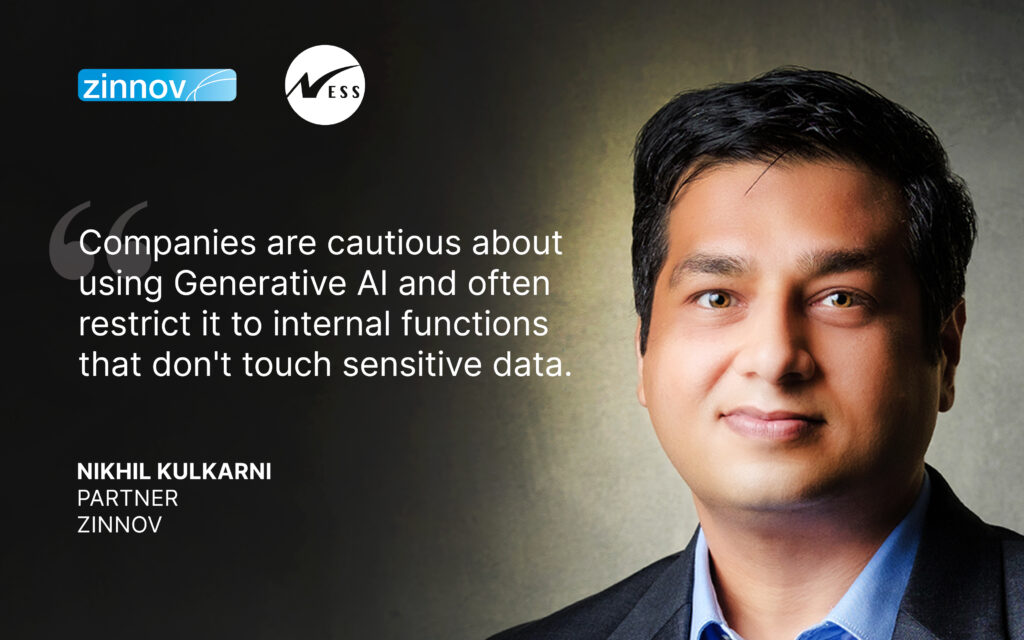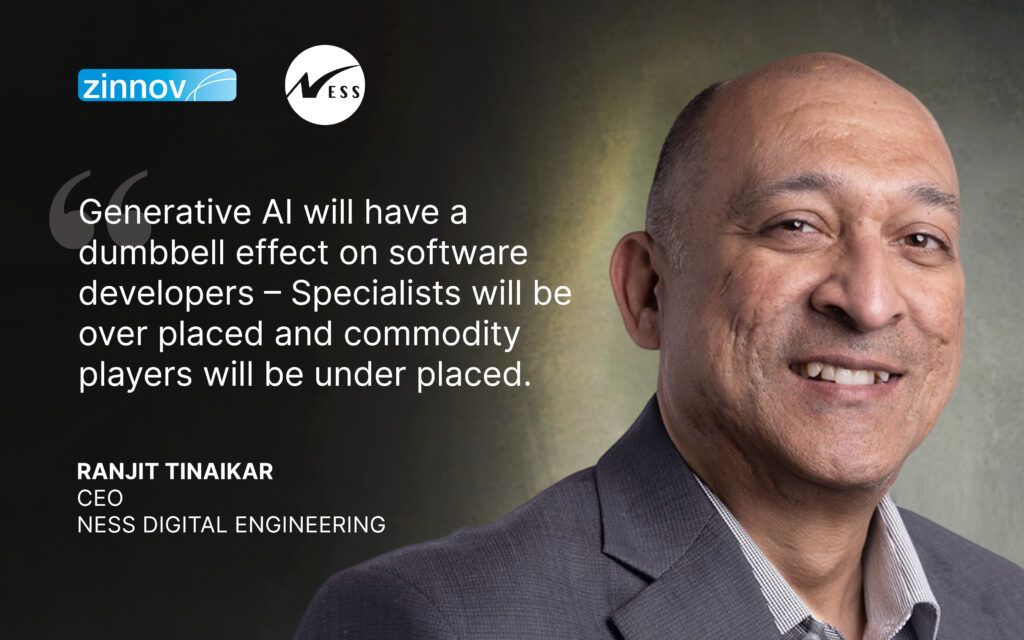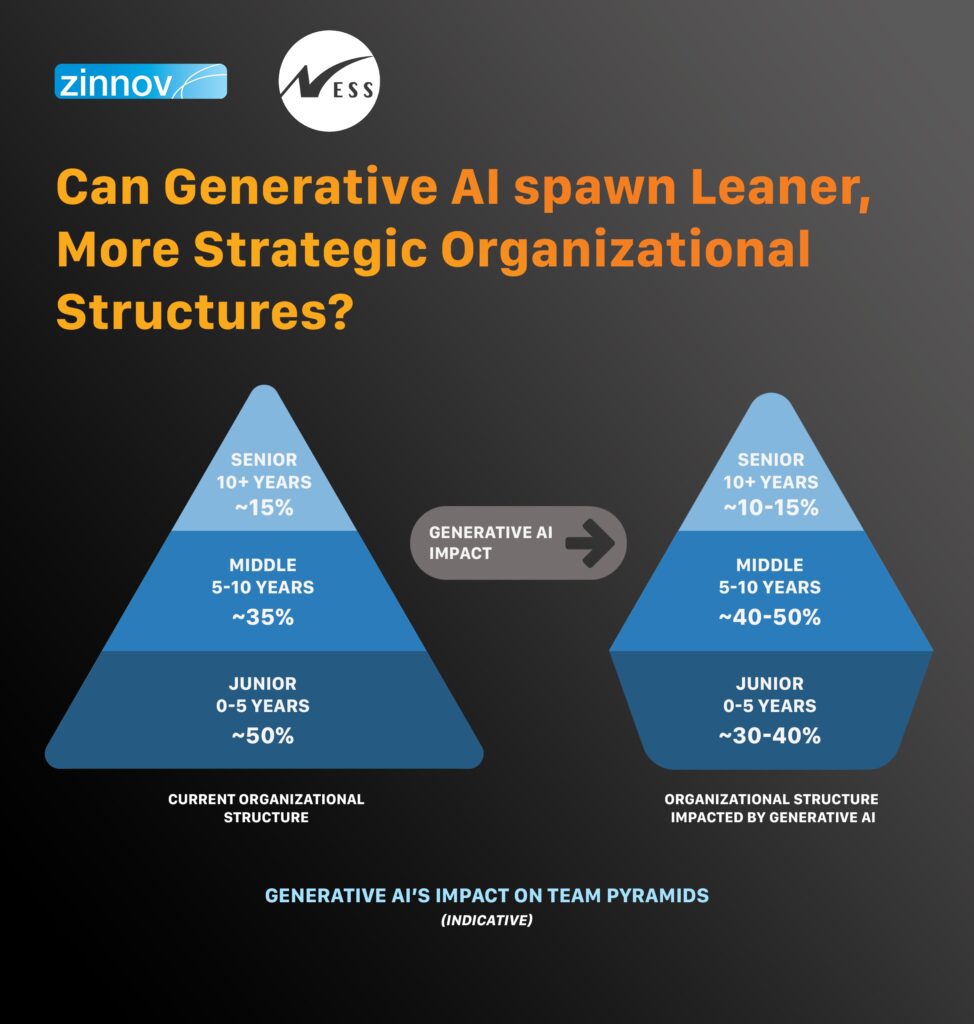Gen AI in Software Engineering: Insights from Top CXOs

Generative AI has been the talk of the town for a long time now, and it’s no surprise that the buzz hasn’t died down. In fact, it’s only gotten louder as more and more people have started to recognize the incredible potential of this technology. But what’s really exciting is that businesses are now starting to sit up and take notice, too. They’re beginning to explore how they can tap into the power of Generative AI to transform the way they work, particularly in the world of Software Engineering.
For those who might be new to the concept, Generative AI is a type of Artificial Intelligence that can generate texts, images, videos, and code by learning from patterns in existing data. It uses Large Language Models (LLMs) to understand and generate text that sounds like it was written by a human, which means it can do things like suggest code completions, catch errors, and even generate entire functions or modules from scratch.
The potential benefits of Gen AI in Software Engineering are pretty staggering. It could help developers work faster and more efficiently, reduce the chances of mistakes, and free up time for more important, strategic tasks. But of course, with any new technology, there are also challenges and concerns that need to be addressed, like making sure that code and data remain secure and figuring out how this technology will change the roles and skills of Software Engineers.
That’s why at a recent industry forum we brought together CXOs and Global Center Heads from different domains to dive into these topics and share their insights and experiences. They discussed everything from practical applications of Generative AI across industries to best practices for integrating it into development workflows, and they didn’t shy away from tackling tough questions about security and the evolving nature of the profession.
In this blog, we’ll explore some of the key themes and takeaways from the forum, so you can get a better understanding of how Generative AI is transforming Software Engineering and what it could mean for your business.
Securing Sensitive Data and Code: Navigating the Risks of Generative AI
When it comes to Generative AI, one of the biggest concerns on everyone’s mind is security. And it’s no wonder – with the vast amounts of data these models are trained on, there’s a real risk of accidentally exposing sensitive information or introducing vulnerabilities through the generated code.
What are the primary security concerns surrounding Generative AI coding tools?
Picture this: you’re a company that deals with a lot of sensitive data, and you’re considering using a Generative AI coding tool like Co-pilot to help your developers work more efficiently. But then you start to worry – what if that tool accidentally leaks some of your confidential information through the code it generates?
And it’s not just a theoretical concern, either. While Co-pilot does offer a setting to prevent code storage by Microsoft, some folks worry that this isn’t enough. They’re afraid that their code could still be used to train the AI model, potentially leading to the leakage of sensitive information.
How are organizations mitigating these risks for practical applications across industries?
But don’t worry, there are ways to mitigate these risks and still take advantage of the incredible potential of Generative AI. It’s all about implementing robust safeguards and being proactive about security.
As one participant noted, “For industries like Banking, Financial Services, and Insurance (BFSI), we recommend using on-premise Generative AI tools like Codeium and Tabnine to prevent any data exposure.“
And for those using tools like GitHub Co-pilot, there’s always the option to disable training data logging.
At the end of the day, it’s all about finding the right balance between harnessing the power of Generative AI and maintaining the security and integrity of your sensitive data and code.
Generative AI in Action: From Assistive Tools to Industry-Specific Applications
When it comes to practical applications of Generative AI, organizations are starting to dip their toes into the water – but they’re being cautious about diving in headfirst.
What use cases are organizations exploring currently?
Right now, most companies are focusing on “low-risk” assistive use cases for Generative AI. These are tasks that help developers work more efficiently, like summarizing code, retrieving relevant information, generating content, and automating testing processes.
But that’s not all – Generative AI is also making waves in other areas, like accelerating existing code updates and facilitating collaboration among engineering teams. Imagine being able to work together seamlessly, with the AI tool acting as a bridge between team members, helping to streamline communication and boost productivity.
However, when it comes to “high-risk” mission-critical tasks, like software for aviation, nuclear plants, or self-driving vehicles, the industry is taking a more cautious approach. These systems demand ultra-high reliability, and current Generative AI technology just isn’t quite there yet.
But that doesn’t mean that different industries aren’t already exploring the potential of Generative AI. At the forum, participants shared some notable examples of how various sectors are leveraging this technology.
For instance, the Software, Internet, Media, and Entertainment segments are currently witnessing the highest number of Generative AI use cases. It’s like these industries are the early adopters, eagerly experimenting with the technology to see how it can help them work smarter and faster.
Energy and Utility companies, like Schneider Electric, are also getting in on the action. They’re using Generative AI for hardware/software development, coding, and test automation – it’s like having a robot assistant that can help with all the nitty-gritty details.
In the Financial sector, institutions like Morgan Stanley are prioritizing use cases such as information retrieval, content generation, summarization, and building assistive platforms for financial advisors.
Service Providers are also actively integrating Generative AI. Companies like BMC are using it to bridge knowledge gaps between legacy and modern codebases – it’s like having a translator that can help you understand and work with different programming languages seamlessly.
However, in risk-averse domains like Banking, Finance, Pharma, and Healthcare, widespread Generative AI adoption may take a bit longer. These industries have strict regulatory requirements, and introducing new technologies can be a bit like navigating a minefield. As one participant noted, “Regulators have concerns when AI is used for decision-making but don’t scrutinize its use for routine operations as closely.” So, for now, these sectors are focusing on low-risk operational use cases.
Is Generative AI making coding skills obsolete?
Far from it! Generative AI is actually creating new opportunities for developers to level up their skills and take on more high-value work. It’s like having a superpower that can help you do more with less effort.
As mundane tasks become automated, developers will have the chance to focus on more challenging and rewarding projects. They can combine their coding expertise with deep domain knowledge to create truly innovative solutions.
Of course, this paradigm shift will require some adjustments in terms of organizational structures, learning strategies, and skill prioritization. But that’s all part of the exciting journey that lies ahead!
How much productivity is Generative AI boosting?
The numbers speak for themselves – organizations that have implemented Generative AI tools are already seeing some seriously impressive productivity gains.
For example, a recent study by Zinnov and Ness Digital Technologies found that using Generative AI for existing code updates led to a whopping 70% reduction in task completion time. That’s like finishing a marathon in half the time it usually takes!
And it’s not just about speed – companies like Schneider Electric reported a 20% drop in basic coding errors and defects, with productivity gains ranging from 20% to 50% across experience levels.
As one participant put it, “Training our engineers on prompt engineering unlocked immediate productivity benefits from Generative AI.” And the results are showing up in other metrics too, like faster commit rates, shorter code review times, and happier developers overall.
What’s the impact on organizational structures?
Get ready for a shake-up in the world of Software Engineering teams. The rise of Generative AI is poised to disrupt the traditional pyramid-shaped hierarchy, where there are a lot of junior engineers at the bottom and fewer senior developers at the top.
Instead, we might start seeing flatter, diamond-shaped structures emerge. In this model, senior developers with deep contextual knowledge will leverage AI tools to amplify their productivity, while the need for junior engineers may diminish.
This shift will require a rethinking of learning and development strategies, with a greater emphasis on cultivating domain mastery over mere technology skills. It’s like the difference between being a jack-of-all-trades and a master of one – in the age of Generative AI, it’s the specialists who will really shine.
But don’t worry – this doesn’t mean that junior developers will become obsolete overnight. It’s more about a gradual evolution of roles and responsibilities, as the industry adapts to the new possibilities opened up by Generative AI.
Navigating the Generative AI Revolution: Embracing the Future
As the world of software development continues its rapid evolution, the insights and discussions from industry leaders serve as a valuable guide for organizations navigating the opportunities and challenges presented by generative AI. By adopting a strategic approach, maintaining robust safeguards, and fostering a culture of continuous learning and adaptation, companies can unlock new levels of efficiency, innovation, and competitive advantage.
Many questions remain about integrating generative AI into your engineering teams, but one thing is clear: this technology has the potential to revolutionize the way your engineers work.
One way to evangelize this across organizations is through dedicated AI Centers of Excellence (COE), which can play a pivotal role in advising, guiding, and overseeing AI projects within the organization. In fact, an AI COE can serve as the vital bridge that connects executive decision-making with the pragmatic implementation of AI initiatives.







